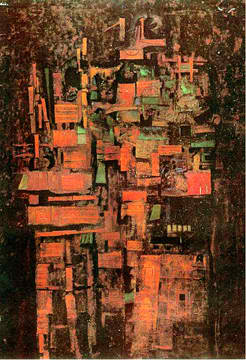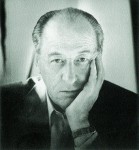
Gunther Gerzso
Mexican, 1915-2000
Dos personajes (Two People), 1956
oil on canvas
36 x 26 1/2 in.
SBMA, Gift of Charles A. Storke
1994.57.12

Undated photo of Gerzso
"Rumor has it that he is our best abstract painter. That is quite true, but it is not the whole story: he is one of the great Latin American painters."
- Octavio Paz, 1963
COMMENTS
“Gerzso’s work represents a new direction in Mexican painting at the mid-twentieth century,” said Curator Diana du Pont. “A pioneering form of abstraction, it proves that Surrealism in exile in Mexico was as crucial to the development of Gerszo’s painting as it was for the New York Abstract Expressionists. His paintings exemplify the shift inward among international vanguard artists like Adolph Gottlieb, Jackson Pollock, Barnett Newman, and Mark Rothko to a new focus on the self and on myth, psychoanalysis, and indigenous art of the Americas.”
Creating a personal and poetic style of abstraction rooted in nature, architecture, and the human figure, Gerzso articulated a new direction in modern Latin American art. Looking beyond the socially committed and dramatically expressive mural painting of Los Tres Grandes (The Three Great Ones), Diego Rivera, David Alfaro Siqueiros, and José Clemente Orozco, he embraced a fresh spirit of internationalism and a firm commitment to the poetic possibilities of formalism.
The early mature years of the late 1940s and 1950s mark the emergence of Gerzso’s signature style. In this period, Gerzso turned toward an expressive geometric abstraction that still referred to objective reality. Fascinated by Maya and Aztec ruins, Gerzso strongly identified with the use of the square in pre-Columbian architecture and transformed this fundamental shape into an icon.
…[T]he fully mature years of the 1950s and 1960s…explore Gerzso’s important relationship to Abstract Expressionism in the United States and to Informalismo/Art Informel in Europe and how he responded to these latest ideas in art by developing a poetic form of abstraction that was at once indigenous and international.
“Working independently from the mainstream, Gerzso risked abstraction at a time when such risk was not rewarded, but he followed his own individual path anyway,” concludes du Pont. “In this unusual position he was in Mexican painting a symbolic bridge between Surrealism and the new wave of Mexican art that became known as La Ruptura. As the next generation of Mexican artists said, ‘[I]t was Gerzso who started a new revolution in the 1950s’.”
Santa Barbara Museum of Art
Risking the Abstract: Mexican Modernism and the Art of Gunther Gerzso
Prepared for the SBMA Docent Council website by Ralph Wilson and Loree Gold 2013
SBMA CURATORIAL LABELS
Gunther Gerzso has been hailed as Mexico’s premier abstract painter. Creating a personal style of abstraction rooted in nature, architecture, and the human figure, Gerzso articulated a new direction in modern Latin American art. Looking beyond the socially committed and dramatically expressive mural painting of Los Tres grandes, or “The Big Three” of Mexican muralism, he embraced a new spirit of internationalism and a firm commitment to the poetic possibilities of formalism.
Dos personajes is a definitive example of the beginning stages of Gerzso’s mature style. It demonstrates the artist’s transformation of the human figure through abstraction. Composed of irregularly shaped planes of saturated color that suggest two people, Dos personajes exemplifies the formal geometric scheme that Gerzso would subtly reinvent in different ways over the next four decades. In emphasizing the poetic nature of Gerzso’s work, Mexico’s Nobel-prize winning writer, Octavio Pax, characterized such tectonic and coloristic compositions as “a system of allusions rather than a system of forms.”
- SBMA Wall Text, 2000
